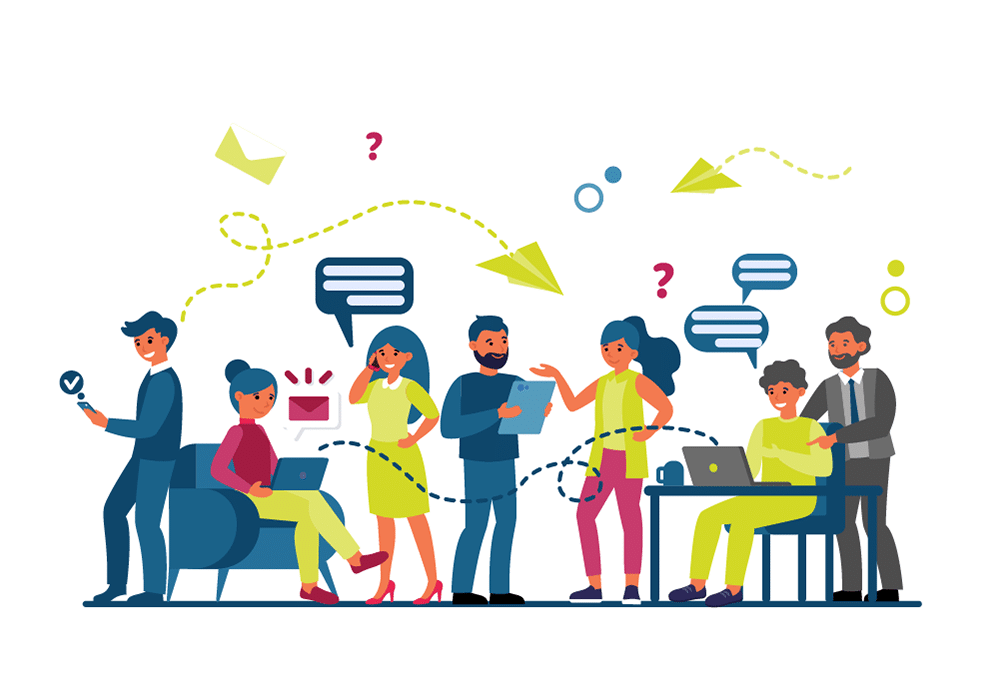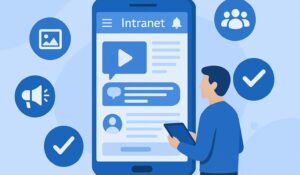The rise of social intranet software reflects today’s shift from static portals to dynamic, engagement-centric digital workplaces. Unlike traditional intranets—often one-way, document-heavy silos—modern social intranet platforms combine the familiarity of social media with enterprise-grade functionality to foster connection and community. With social feeds, peer recognition, and seamless communication, they transform how teams collaborate, especially in hybrid and distributed environments.
Are you future-proofing your workforce with tools Gen Z and Millennials expect, or staying stuck with legacy systems that disengage employees? Social intranets are designed to evolve with where workforces are headed, not where they’ve been.
Discover how these solutions redefine employee engagement and explore our intranet software guide to understand the broader landscape.
What Is a Social Intranet?
A social intranet is a private, internal tool that not only delivers news and documents but also blends in social media-style interaction—think feeds, commenting, tagging, and peer recognition. Its purpose? To break down silos, deepen engagement, and build a culture that spans departments, campuses, and time zones. Compared to one-way traditional intranets, social intranets invite participation, content creation, and real-time conversation, making them hubs for authentic connection and collaboration.
👉 Explore more about driving effective intranet communications.
Key Features of Social Intranet Software
A modern intranet platform typically includes:
- Dynamic social feeds with likes, comments, and personalized updates
- Peer recognition systems: shout-outs, badges, and reward programs
- Groups and communities, complete with tagging and discussion threads
- Employee profiles and activity streams to spotlight contributors
- Interactive comments and tagging, akin to social media
- Deep integrations with tools like Slack, Teams, Microsoft 365, HRIS, CRMs, etc. (Sociabble, HubEngage, Axero Solutions)
Gen Z impact: Social intranet platforms align perfectly with younger workforces. Nearly half (49%) of Gen Z employees prefer instant messaging over email at work, often expressing themselves with emojis, GIFs, and informal tone (Source: Cake.com). And since over 50% of Gen Z spend 4+ hours daily on social media, features like feeds, tagging, and reactions feel natural and engaging to them (Source: Qureos).
👉 Explore these features on HubEngage’s employee intranet platform.
Why Social Intranet Platforms Matter
Social intranet software delivers tangible workplace improvements:
- Boosts engagement and retention by fostering belonging, recognition, and voice.
- Strengthens company culture, making it visible and inclusive no matter where employees work.
- Breaks down silos with two-way chats, file sharing, and community tagging that streamline decisions.
- Enhances productivity and knowledge sharing with powerful search, centralized file access, and consolidation of tools—reducing context switching.
- Meets Gen Z expectations: 40% of Gen Z workers feel more comfortable communicating digitally than face-to-face, even when colleagues are nearby (Source: The Sun). With 75% believing technology enhances productivity, adopting advanced intranets ensures organizations attract and engage this generation (Source: Venn).
- Higher overall impact: Research shows that organizations implementing internal social platforms saw a 20% increase in employee satisfaction and a 20–25% boost in productivity among knowledge workers (Source: Axero Solutions). Additionally, 60% of companies report improved engagement when intranets emphasize interactive features. In contrast, 77% of employees feel disconnected under ineffective static intranet communication (Source: Oak.com).
💡 Proof Point: One HubEngage client in hospitality saw its internal survey participation rise by 45% after launching a social intranet, alongside a measurable uplift in Glassdoor ratings. Case studies like these show real ROI.
💡 Proof Point 2: A manufacturing client reduced onboarding time by 30% after adopting HubEngage’s social intranet solution, demonstrating clear business impact beyond engagement.
Traditional vs. Social Intranets
| Feature / Metric | Traditional Intranet | Social Intranet |
|---|---|---|
| Content Flow | Top-down announcements only | Two-way, employee-generated & interactive |
| Engagement | Passive; low adoption | High; designed for participation and feedback |
| Culture & Recognition | Minimal/hidden | Visible peer recognition and community building |
| Tool Integration | Standalone or legacy integrations | Deep, seamless with collaboration & comms tools |
| Search & Navigation | Often inefficient, scattered content | Unified, intuitive, faster to find what’s needed |
| Updates & Upgrades | Slow, resource-heavy | Frequent, agile, future-proof |
| Technology Requirement | Primarily managed by IT | Co-owned by IT + Communications for strategy & adoption |
With social intranet platforms, your workplace becomes a living, evolving network—not just a static resource library. Traditional systems may store documents, but social intranet software fuels culture and future-readiness. Employees adopt and love them because they work the way modern teams expect.
How to Choose the Right Platform
When evaluating your options, consider:
- Engagement Tools: feeds, recognition features, community forums
- Mobile User Experience: instant access for frontline and remote teams
- Integrations: with Slack, Teams, HRIS, CRMs, etc.
- Analytics & Insights: content impact, usage trends, sentiment tracking
- Ease of Adoption: intuitive UI, low training requirements
- Scalability & Governance: roles, permissions, secure content management
Here are some popular social intranet options:
- Workvivo is known for emotional engagement and ease-of-use but lacks advanced omnichannel tools.
- Staffbase excels at broad communication—email, mobile, push alerts—positioning itself as ideal for enterprises with diverse comms needs.
- Simpplr consistently appears as a leader across Gartner, Forrester, and G2 reports for feature completeness and execution.
- Unily offers a customizable employee experience platform rich in personalization and engagement.
- HubEngage stands out by combining all these strengths into one unified platform—seamlessly blending social intranet features, recognition, multi-channel communication, gamification, and ROI-focused analytics—helping organizations scale without juggling multiple tools.
👉 Ready to see the difference? Book a demo with HubEngage and compare firsthand.
👉 Learn more about broader intranet providers if you’re evaluating vendors.
Real-World Use Cases
Here’s how social intranet platforms play out in practice:
- Peer Recognition Campaigns — Employees give public shout-outs that boost morale and visibility.
- Idea-Sharing Forums — Cross-departmental innovation thrives when teams share suggestions in dedicated groups.
- Project Collaboration Spaces — Teams use group feeds to share files, update statuses, and comment in real time.
- Onboarding Communities — New hires find peer support through welcome groups and searchable knowledge hubs.
👉 See best intranet websites and examples for inspiration.
The Future of Work with Social Intranet
These platforms are rapidly evolving with:
- AI-powered personalization: customized feeds, smart content suggestions
- Smart tagging and micro-learning, delivering bite-size resources to the right people
- Embedded video, real-time collaboration, and live events for richer engagement
Unlike legacy intranets that stagnate, social intranet software is designed to evolve—keeping pace with generational shifts, new workstyles, and AI-driven personalization.
👉 Learn more about AI powered intranet workplaces.
Conclusion: Bring Engagement to Your Intranet
Social intranet platforms are transforming digital workplaces—making them vibrant, inclusive, and collaborative. By offering conversation, recognition, and intuitive tools, they elevate engagement, productivity, and culture. Let HubEngage help you deliver that modern experience—discover our employee intranet platform today.
FAQs
What is a social intranet?
A social intranet is an internal platform enhancing traditional intranet features with social interaction—feeds, comments, peer recognition—to nurture collaboration, culture, and engagement. Learn more about different intranet platforms.
How does a social intranet differ from a traditional intranet?
Instead of static announcements and document stores, social intranets enable participation, personalized interactions, real-time updates, and more dynamic connections.
What are key social intranet features?
Includes activity feeds, peer recognition, communities/groups, employee profiles, commenting/tagging, integrations, mobile access, and analytics.
How do social intranet platforms support hybrid work?
They break silos with real-time collaboration, ensure remote/frontline inclusion, foster belonging, centralize knowledge, and reduce reliance on dispersed tools.













